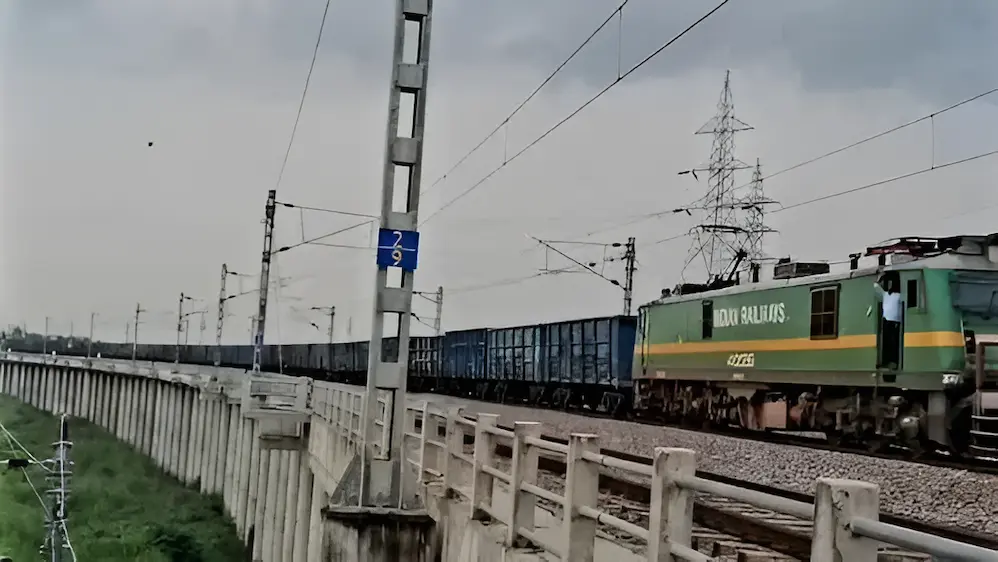
India’s Rudrastra freight train spans 4.5 km with 354 wagons, setting an Asian record
In a monumental stride for Indian Railways and the continent’s freight transport capabilities, India has launched Rudrastra, a freight train stretching an astonishing 4.5 kilometres, the longest ever operated in Asia. This engineering marvel, comprising 354 wagons and powered by seven locomotives, is not just a logistical feat but a symbol of India’s growing prowess in infrastructure innovation.
The name Rudrastra, derived from ancient Sanskrit meaning “weapon of Rudra,” evokes power, precision, and unstoppable force, an apt metaphor for a train designed to revolutionize bulk cargo movement across the country.
The Birth of a Behemoth
The mega-train was conceptualized and executed by the Pandit Deendayal Upadhyaya Division of the East Central Railway, headquartered in Uttar Pradesh. The idea was simple yet bold: instead of dispatching six separate freight trains, why not combine them into one colossal convoy?
This vision materialized into Rudrastra, a train that would carry massive loads across industrial corridors with unmatched efficiency. The trial run, conducted between Ganjkhwaja (Chandauli, UP) and Garhwa Road (Jharkhand), covered 209 kilometers in just under five hours, maintaining an average speed of 40.5 km/h.
Anatomy of Rudrastra: Engineering Excellence
Creating a train of this magnitude required meticulous planning and flawless execution. Rudrastra was assembled by coupling six standard-length rakes, each typically operated as an independent freight unit. These were then configured into three long-haul racks, with each rack consisting of two standard trains.
Technical Highlights:
- Total Length: 4.5 kilometers
- Wagons: 354, each loaded with 72 tonnes
- Locomotives: 7 (2 at the front, 1 after every 59 wagons)
- Crew Coordination: Multiple teams synchronized across control centers
- Infrastructure Readiness: Reinforced tracks, advanced signaling systems
The placement of locomotives was critical. With such a long train, distributed power was necessary to maintain traction, reduce stress on couplers, and ensure smooth braking. The engines were strategically positioned to balance the load and prevent derailment.
Strategic Significance: Why Rudrastra Matters
Rudrastra isn’t just a record-breaking train—it’s a strategic asset. In a country where logistics costs account for 13–14% of GDP, innovations like this can dramatically improve efficiency and reduce expenses.
Key Advantages:
- Time Savings: One long convoy replaces six separate journeys
- Resource Optimization: Fewer crew members, reduced fuel per tonne
- Increased Corridor Capacity: Frees up space for additional trains
- Cost Efficiency: Lower operational costs for bulk transporters
- Environmental Impact: Reduced emissions per unit of cargo
Railway officials hailed Rudrastra as a “stellar example of coordination, innovation, and execution.” It demonstrates how Indian Railways is evolving from a traditional transporter to a modern logistics powerhouse.
Behind the Scenes: Innovation Meets Execution
The successful trial of Rudrastra was the result of months of planning, simulation, and cross-departmental collaboration. Engineers had to ensure that the train could navigate curves, gradients, and station platforms without compromising safety.
Operational Challenges Overcome:
- Signal Synchronization: Coordinating signals across a 4.5-km stretch
- Real-Time Monitoring: Sensors and control systems tracked performance
- Crew Training: Specialized training for multi-locomotive coordination
- Emergency Protocols: Contingency plans for breakdowns or decoupling
Divisional Railway Manager Uday Singh Meena described Rudrastra as a “new experiment” that will “make freight transportation and loading quick.” He emphasized its role in “saving time, increasing capacity, and reducing costs.”
A Viral Moment: Public Reaction and Media Buzz
When Railway Minister Ashwini Vaishnaw shared a video of Rudrastra on social media, it quickly went viral. The footage showed the train snaking across the landscape like a steel serpent, drawing awe and admiration from viewers across the country.
The minister called it “Bharat’s longest freight train”, and praised the team behind its execution. News outlets dubbed it a “logistics revolution”, and industry experts began speculating about its potential to reshape freight movement in India.
Rudrastra and India’s Freight Future
Rudrastra is more than a one-off achievement—it’s a blueprint for the future. As India expands its Dedicated Freight Corridors (DFCs) and modernizes its rail infrastructure, mega-trains like this could become routine.
Future Possibilities:
- Expansion of Long-Haul Operations: Across key industrial zones
- Integration with Multimodal Logistics Parks: Seamless cargo transfer
- AI-Powered Scheduling: Optimizing routes and load distribution
- Private Sector Collaboration: Scaling operations and reducing costs
This aligns with India’s broader goals of:
- Reducing logistics costs to under 10% of GDP
- Boosting exports through faster inland connectivity
- Decarbonizing transport by shifting freight from road to rail
Rudrastra’s success could inspire similar innovations in other sectors, from agriculture to manufacturing, where bulk transport is essential.
Infrastructure Readiness: Building for Scale
To accommodate Rudrastra, Indian Railways had to ensure that tracks, bridges, and stations could handle the load. This involved:
- Track Reinforcement: Strengthening rails and sleepers
- Platform Extensions: Adjusting lengths for loading/unloading
- Signal Upgrades: Installing advanced systems for long-train detection
- Control Center Modernization: Real-time data integration
These upgrades not only support Rudrastra but also pave the way for future mega-trains, making India’s rail network more resilient and future-ready.
Rudrastra as a Symbol of Scale and Speed
Rudrastra is not just a train, it’s a statement. It represents India’s ambition to lead in infrastructure, logistics, and innovation. It shows what’s possible when vision meets execution, and when tradition embraces technology.
As Asia’s longest freight train, Rudrastra has set a new benchmark. It’s a symbol of scale, speed, and strategic foresight. And it’s a reminder that India’s railways are not just moving goods, they’re moving the nation forward.
India’s First Bullet Train Station in Surat Nears Completion: A Game-Changer for High-Speed Rail
2006 Mumbai Train Blasts Case – Supreme Court Stays Bombay HC Acquittal : A Legal Turning Point
1 thought on “ Rudrastra: India’s 4.5-KM Freight Train That Redefined Asian Rail Logistics”
Comments are closed.